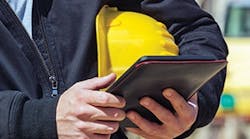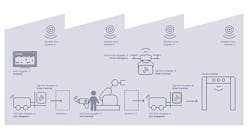Read Part 1: Mobile process automation monitoring and control evolves
Because process facilities and applications typically include difficult and dangerous environments, going mobile means bringing along added protections for people and devices alike.
Dave Stock, president of Innovative Control Inc., a system integrator and CSIA member in Algonquin, Ill., reports that users in harsh or hazardous settings must often wear protective gear that makes it difficult to manipulate small devices, navigate between screens or use touchscreens. "Many operators have glasses, gloves, Tyvek suits or other personal protective equipment (PPE) on and can't touch screens or many buttons, so in about 2010, we started adding barcodes they could scan to activate on/off or other functions. We also forced ourselves to design screens with just three large buttons on the bottom, which could be assigned different functions depending on where users are in their applications.
Figure 1: SMT70 FieldXpert tablet PC from Endress+Hauser is designed to be used on the plant floor, can withstand heavy impacts, is dustproof, can be used in hazardous environments, and has built-in connectivity, usually WiFi and LTE. Source: Endress+Hauser
"Many users also run batches following the ANSI/ISA-88 batch standard, and can use this barcode method to respond to prompts using their handhelds. We also built a library of tools that bring S88 batch concepts onto handhelds, such as using colors and blinking lights or shapes to direct users to take different actions."
Though there are many useful tools for aiding mobility, Stock explains they must be adapted to the specific needs of each user and the individual process where they'll be applied. "You have to think through the purpose and need for mobility in each case because every user and application is different," explains Stock. "If a user needs control, more design time may be needed to structure their mobile device's navigation by learning what data is most important to the operators, deciding if they need vertical bar indicators or some other display, and determining how much control to give and to whom?
"You have to try and experiment because you'll always be smarter second time around. This is where our barcode-based command structure came in. Another client couldn't use a typical, small stylus on their screens because of their gloves, so we asked a machinist for a knitting needle-sized one, and he developed a 3/8 in. x 8 in. Teflon stylus just for that customer."
To protect mobile device themselves, Stock adds it helps to have defined spaces to put them down, such as shelves or holsters in their field. Innovative Control also implements intrinsically safe (IS) tablet PCs from ecom instruments, a Pepperl+Fuchs brand, and deploys them with its Bluetooth-based barcode solution. "We also work with each client's IT group to ensure cybersecurity at the application and device levels," says Stock. "We usually employ encryption, but the physical proximity required to use barcodes provides even more security."
Steffen Ochsenreither, business development manager at Endress+Hauser, reports that, "Mobile devices such as tablet PCs and smart phones have clear advantages in harsh environments because they can be made dustproof and waterproof more easily. Given the right certification, they can also be used in hazardous areas. Here, there is a clear trend to more rugged, robust devices."
Figure 2: Skills Insights Intelligent Wearables products from Honeywell combine RealWear's HMT-1Z1 hands-free, head-mounted computer with Honeywell's Movilizer cloud-based workflow solution to support field service operations, especially in hazardous locations. Source: HOneywell
Ochsenreither adds that SMT70 Field Xpert tablet PC from Endress+Hauser is designed to be used on the plant floor, withstands heavy impacts, is dustproof, and can be used in hazardous environments (Figure 1). "With its built-in connectivity, usually WiFi as well as LTE, SMT70 lets mobile workers make sure they're always connected and have all information needed to complete their tasks."
Wear it well
Because laptops, tablets and even smart phones can be unwieldy for technicians and operators who need their hands free in the field, many developers have been devising interfaces they can wear and interact with more easily.
For instance, Honeywell just launched its Skills Insights Intelligent Wearables products that combine RealWear's HMT-1Z1 hands-free, head-mounted computer with Honeywell’s Movilizer cloud-based workflow solution to support field service operations, especially in hazardous locations. Its head-mounted visual display responds to voice, and brings live data, documents, work procedures, and health and safety information into view. This wearable technology also features operator task automation; live data visualization; video capture and playback; expert on call; geo-localization, navigation and asset visualization; rapid emergency evacuation; and man-down assistance (Figure 2).
“This new Honeywell Connected Plant technology offers industrial workers the information they need when they need it, wherever they are,” says Youssef Mestari, program director, Honeywell Connected Plant. “That means workers carry with them decades of relevant expertise that's accessible at any time via simple voice activation.”
Likewise, Guardhat reports it's developed a hardhat that's also a fully functional, screen-less Android communication device. It's scheduled to launch its latest version in August, and release an intrinsically safe version in 4Q18.
Figure 3: The developers at Guardhat (I. to r.), Senni Perumal, head of development; Anupam Sengupta, CTO; and Mark Schlander, VP of sales and alliances, show off their combination hardhat and screenless Android device that precisely locates workers in a 3D space in less than 1 second and communicates between individuals, teams and their enterprise. Source: Jim Montague
Mark Schlander, VP of sales and alliances at Guardhat, explains that Guardhat lets users:precisely locate workers in a 3D space in less then 1 second; communicate directly between individuals, teams and the enterprise; understand the environments workers are facing in real-time; and make workplaces enterprise transparent by gathering, analyzing and acting on data before, during and after events. In addition, Guardhat can integrate with GPS, and switch to it when users go outside, if a local GPS network is installed and available. Guardhat's transponder has a 6- to 12-month battery, depending on usage, and can add an external power supply or charging station as needed (Figure 3).
"Guardhat can use 2.5 GHz when 2-meter accuracy is needed, and it won't interfere with other wireless networks," says Schlander. "Or, it can use 3-7 GHz UWB for 20-cm accuracy by communicating with four anchors and triangulating."
Have control room, will travel
On a larger scale than smart phones and tablet PCs, system integrator Quantum Controls Inc. in Elkton, Md., is designing and building skids containing mobile control stations for mining, waste materials and equipment testing applications, which are typically in locations where normal communications aren't available. Once testing or a job is done at one site, they can be brought back, refurbished and sent back out.
These custom-made skids vary from 12 X 12-ft. to 40 X 9 ft., shipping container-sized units. Inside, they contain computers, HMIs, desks, wall-mounted benches, air filters, data servers, switches, LED lighting, electrical panels, Ethernet networking, remote connections via virtual private networks (VPN), and 60-A to 255-A, multi-tap transformers for customers' voltage variations. Anything that's mounted outdoors is NEMA 4-rated. They're also integrated with controls, including Rockwell Automation's ControlLogix, Emerson's DeltaV DCS and Siemens Simatic PCS 7.
"We tried to put all these devices and functions in a cabinet and control it remotely, but our clients wanted a place in the field where operators could test equipment and run the HMI and data servers, so we developed these mobile control rooms," says Brandon Blake, electrical designer at Quantum. "Now, all they need to bring to them is power and Ethernet with an Internet connection."
Bake reports that Quantum has built 12 mobile control rooms so far. "Even though they're often shipped to challenging environments, we can keep the inside at 70°F at all times due to the server and operations equipment needing to stay cool," adds Blake. "With the internal data server, we can give the process plant or self-contained test unit whatever data its operators want, and transfer other data up to the engineering and business side. Quantum can get alerts and alarms, too, and help with these continual adjustments and changes."
To overcome lack of communications where they're installed, Quantum's mobile control rooms use Ethernet with Cat 6e cables that are shielded, 600 V-rated and have NEMA 4 modular connectors if plug-and-play configuration is needed. If Ethernet isn't possible, 3G cellular is used. "We start with eWon's 3G cellular VPN service or a plant-supplied cellular modem to remote and send our data via file transfer protocol (FTP)," explains Blake. "We also double scan files, once before sending and again when they reach the FTP site, before users access them."
Blake adds Quantum is planning smaller versions of its mobile control stations, especially for users that don't need testing equipment in the enclosure. "We're also thinking of putting encrypted WiFi in the cabinet, and using more mobile tablets that can be taken onsite to view HMI screens because there are testing and tasks that don't need a whole mobile station," says Blake. "Users may be able to look through windows kits installed on a cabinet or at tablets in onsite enclosures, though many users like seeing displays on PC-based HMI systems onsite in real time."
Rein in remoteness
Whatever format or guise mobility appears in, its primary aim remains the same—to shorten the distances between events in the field and the eyes and minds of its users. For example, Parker Boiler in Commerce, Calif., near Los Angeles, recently worked with system integrator Diverse Devices in Costa Mesa, Calif., to develop a PLC-based control system with an advanced PID algorithm to sequence multiple boilers with help from Modbus RTU or 4-20 mA networking. This solution can minimize downtime, simplify maintenance and provide regulatory compliance, but it also requires remote access for alerts, adjustments, maintenance and troubleshooting.
Figure 4: Parker Boiler has implemented MicroSmart FC6A PLC and 10-in. HG3G HMI from IDEC Corp. to run its PID algorithm and connect to the Internet for browser-based access to its boiler systems from any Internet-enabled laptop, tablet PC or smart phone. The PLC, HMI and other components are all housed in a 16 X 16 X 8 in. enclosure, and the combined automation system can control up to eight boilers. Source: IDEC
As a result, Diverse Devices picked MicroSmart FC6A PLC and 10-in. HG3G HMI from IDEC Corp. to run IDEC's PID with Derivative Decay (PIDD) instruction. The controls connect to the Internet via the HMI, which provides browser-based access to the boiler system from any Internet-enabled laptop, tablet PC or smart phone, and allows alerts and alarms to be sent to local or remote staff via text message or email. The PLC, HMI and other components are all housed in a 16 x 16 x 8 in. enclosure, and this combined automation system can control up to eight boilers (Figure 4).
"We can also remotely monitor, diagnose and upgrade the PLC program, mostly over a cellular network that's more secure and convenient," says Jack Heiser, president of Diverse Devices. "Program maintenance, troubleshooting assistance and feature upgrades are also handled remotely by connecting to a cellular modem inside the enclosure." Noel Shamoon, chief programmer at Diverse Devices, agrees that, "We have systems deployed all over the U.S. and in a few other countries, and we never have to leave the office to support their controllers."
Don Pham, product manager at IDEC, adds that, "The more dispersed the process, the more sense it makes sense to monitor them with handheld devices. If all elements of the process are contained in a relatively small area, as with most pharmaceutical facilities, then one local and permanently mounted HMI can be used. When the process begins to cover a wide geographical area, as with a big chemical plant, it makes more sense to carry your HMI with you as there might not be a local one."
[sidebar id=8]






